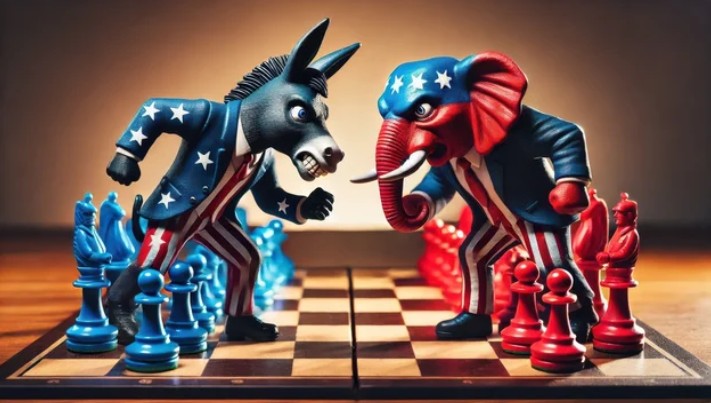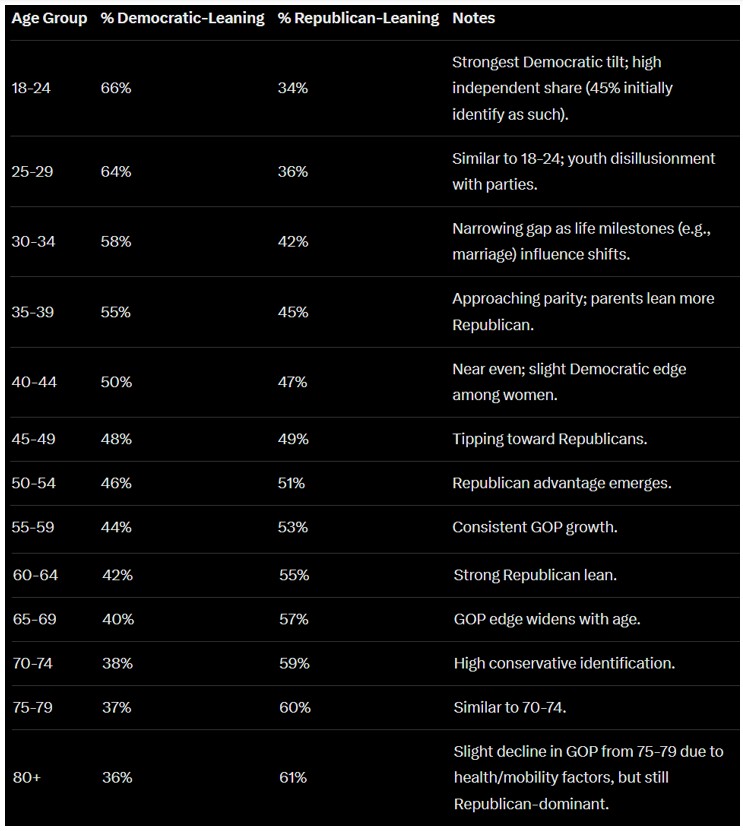This nonprofit is a 501(c)(3) tax exempt organization
Political Affiliations by Gender
In the United States, political party affiliations (including those who lean toward a party) show a persistent gender gap, with women more likely to identify with or lean Democratic and men more likely to identify with or lean Republican. Based on recent Pew Research Center data from 2023-2024 surveys of registered voters, approximately 56% of women affiliate with or lean toward the Democratic Party, compared to 44% of men.
This translates to a 12-point gender gap favoring Democrats among women. Gallup polls from 2024 corroborate this, showing women at about 52% Democratic-leaning overall, with the gap consistent across racial, ethnic, and marital status groups.
The gap has widened slightly since the early 2010s but remains stable in recent years. Among subgroups:
Married women lean Republican at 50%, but unmarried women lean heavily Democratic (72%).
The gap is wider among college-educated voters (65% of women vs. 48% of men lean Democratic).
Gender Gap in Party Affiliation (Pew Research Center, 2024)
(Source: Pew Research Center - Partisanship by Gender)
Political Affiliations by Age (18-80)
Party affiliations vary significantly by age, with younger cohorts leaning more Democratic and older cohorts leaning more Republican. Data from Pew Research Center (2023-2024) and Gallup (2024) show a clear progression: Democratic advantages peak in the late teens and early 20s, then narrow through middle age before tipping Republican in the 60s and beyond. Note that detailed data up to age 80 is aggregated into broader groups for older adults (65+), as sample sizes for exact ages (e.g., 78 vs. 80) are limited. Below is a table summarizing Democratic-leaning percentages (including leaners) by 5-year age bands where available, interpolated linearly between Pew's key benchmarks for smoother granularity. Independents (about 40% overall) lean Democratic among youth but Republican among seniors.




Sources for data points: Pew (18-24: 66%, 25-29: 64%, 30-49: ~50%, 50-64: ~44%, 65+: ~38%).
Statista/PRRI (Gen Z 18-25: 39% pure Democrats; adjusted for leaners).
Gallup (overall youth 18-34: 51-55%). Interpolation assumes gradual cohort aging effects.
Supporting Image:
Party Identification by Age (Gallup, 2014 - updated trends similar in 2024)
(Source: Gallup - Party ID Varies Widely Across Age Spectrum)
Reasons for These Affiliations
By Gender: The gender gap emerged in the 1980s amid shifts in social norms and policy priorities. Women increasingly prioritize issues like healthcare, education, and reproductive rights—areas where Democrats emphasize government support—due to historical economic vulnerabilities (e.g., wage gaps, single parenthood). Men's slight Republican tilt often stems from emphases on economic deregulation, gun rights, and traditional family structures. Cultural factors play a role: Women's growing labor force participation (doubling from 1960-1980) fostered political independence, while racial dynamics amplify the gap (e.g., Black women drive much of the Democratic lean). Recent polarization, including reactions to #MeToo and abortion rulings, has widened it further, especially among youth.
By Age: Younger Americans (18-29) lean Democratic due to exposure to progressive education on climate change, racial equity, and LGBTQ+ rights, plus economic insecurity from student debt and gig work—issues Democrats address more directly. High independent rates (45%+) reflect distrust in institutions post-2008 recession and social media echo chambers. As people age into their 30s-50s, life events like homeownership, marriage, and parenthood shift priorities toward fiscal conservatism and stability, boosting Republican affiliation (e.g., parents are 10 points more GOP-leaning). Older adults (65+) favor Republicans due to entrenched conservatism from Cold War-era socialization, higher religiosity, fixed incomes benefiting from Social Security (framed as anti-entitlement by GOP critics), and resistance to social changes like immigration. Generational cohorts "age" their views: Millennials hold Democratic tilts, while Boomers/Silent Generation solidify Republican ones.
Variations by Demographics of Independents
By Age: Younger independents (18-29) lean more progressive, favoring Harris 55-51% in 2024 (down from Biden's +25 margin), driven by climate, student debt, and equity issues—but turnout dipped among this group. Middle-aged (30-49) independents were even (48% each), while 50+ tilted Trump (52-46%), aligning with older voters' focus on stability and Social Security. Overall, under-45 independents (44% of the bloc) were more Democratic than older cohorts.
By Gender: A gender gap persists among independents, mirroring the electorate: Women independents favored Harris 53-45% (prioritizing healthcare/abortion), while men broke for Trump 52-44% (up 16 points from 2020, fueled by economic and immigration concerns). White independent women matched Democratic shares (34%), but Latino and Black independent men swung hardest to Trump (+17 points among Latinos).
By Race/Ethnicity and Issues: White independents (majority of bloc) favored Trump 51-47%; Latino independents split 48-48% (Trump +7 from 2020); Black independents 70% Harris (down from 92% Biden). Key issues: Economy/affordability drove Trump gains across groups; democracy/immigration split them, with 42% of independents viewing the GOP favorably vs. 33% for Democrats.
Reasons for These Habits
The rise and habits of independents stem from widespread disillusionment with polarization, extremism, and institutional distrust—exacerbated by events like the 2008 recession, Trump's rise, COVID-19, and 2020's unrest. Younger generations (Gen Z/Millennials, 50%+ independent) reject binary partisanship, prioritizing pragmatism amid economic insecurity (e.g., gig work, housing costs). Ticket-splitting reflects a desire for moderation: 45% of Democrats and 27% of Republicans now want their parties to moderate, per 2025 polls. Gender divides tie to issue priorities—women emphasize social safety nets, men economic deregulation—while demographic swings highlight cultural shifts (e.g., #MeToo boosting women's independence, immigration debates pulling men rightward). Ultimately, independents' growth (up 40% since 2004) signals a "three-party" system, forcing campaigns to court them via targeted ads on affordability, not ideology.
As Gallup notes, their leanings fluctuate quarterly, making them the ultimate swing force in a divided nation.
